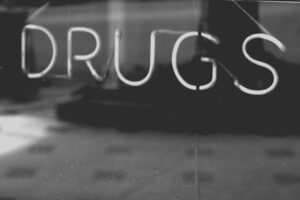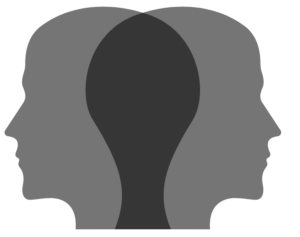Chapter 9: Mental Health and Drugs
By the end of this chapter, you should be able to:
- Examine the dominant beliefs and attitudes in our society with regard to chemical use. (LO1)
- Explain the effects of addiction on individual, family, and community. (LO4)
- Outline and critique current intervention and treatment modalities used in the field. (LO5)
Overview

It is not unusual for there to be co-occuring mental health programs for those with substance abuse disorders. In fact, is it quite common that a patient will enter psychiatric services because of a complication with a substance abuse disorder (Prodromou, 2018). And, a combination of drug and mental health issues increases the likelihood that they will be arrested (Woodhouse et al., 2016; Rossheim, 2018). Unfortunately, there is a gap in services that provide for individuals in these unique scenarios (Prodromou, 2018; Hakobyan et al., 2020) despite the fact that much research has been completed on this topic. Clear treatment guidelines have not necessarily been formed (Larson et al., 2022). This chapter will discuss the this relationship and potential treatment options.
Dual Diagnosis
Definition
 Dual diagnosis is the identification of two disorders occurring simultaneously (APA, 2022). For example, alcohol abuse coexisting with depression. This can also be called comorbidity and can include other psychiatric conditions like learning disabilities (Carvalho & Garner, 2019). Dual diagnosis is well-documented in research, greater than 50% of users having both types of disorders (substance abuse and mental illness) (Saddichha et al., 2015); over eight million people documented to have a dual diagnosis in the United States alone (Carvalho & Garner, 2019).
Dual diagnosis is the identification of two disorders occurring simultaneously (APA, 2022). For example, alcohol abuse coexisting with depression. This can also be called comorbidity and can include other psychiatric conditions like learning disabilities (Carvalho & Garner, 2019). Dual diagnosis is well-documented in research, greater than 50% of users having both types of disorders (substance abuse and mental illness) (Saddichha et al., 2015); over eight million people documented to have a dual diagnosis in the United States alone (Carvalho & Garner, 2019).
Dual diagnosis is a complex condition that requires similarly complex treatment options, tailored to the needs of the individual. Some research suggests medical non-compliance and substance abuse often predicted how well treatment went, noting that that depressive disorders were more common with substance abuse than other mental health disorders further research is needed to better understand how these different disorders interact. (Davis et al., 2022).
Epidemiology
Epidemiology is the “incidence and distribution of diseases and disorders” (APA, 2022), in this case dual diagnosis. Review the slides and statistics below to see the distribution of dual diagnosis for a 2021 study (Ferrer-Farre et al.). Use the arrow in the lower right corner to expand to full screen.
Mental Health vs Substance Abuse
Mental health and substance abuse are both ever-changing pieces of human-centered work. Professionals in these fields can have a pivotal impact in patient lives. Mental disorder is a broad term to describe issues related to emotion, behavior, and mental states. There are several differences between mental health treatment and substance abuse treatment. Here are a few to consider:
- The mental health focus believes that if the mental illness is treated properly, the substance abuse will disappear. The substance abuse focus believes the opposite is true (Inaba, 2011).
- The mental health focus believes in partial recovery, while substance abuse focuses on permanent abstinence (Inaba, 2011).

Some studies show a high rate of satisfaction by individuals who receive treatment for their dual diagnosis, especially those with integrated treatment options (Schulte et al., 2011). The integrative approach involves varied disciplines and services, but this is a complicated approach to take with no clear guidelines. One study suggested an enactive approach which applies theory rather than just explaining it (Larsen et al., 2022). Enactive psychiatry views disorders as “mosaics” of combined disciplinary elements, like biology, psychology, and sociology. These “mosaics” may provide insight on how the individual needs to be treated in order to promote rehabilitation and healing (Larsen et al, 2022).
Dual diagnosis requires that the patient be treated for both things simultaneously, that integrates different disciplines and strategies. There are several treatment options that have proven successful in dual diagnosis, as provided by National Institute for Drug Abuse (2020). Lean more by going to this website: What are the treatments for comorbid substance use disorder and mental health conditions?
- Cognitive Behavioral Therapy
- Dialectical Behavioral Therapy
- Assertive Community Treatment
- Therapeutic Communities
- Contingency Management or Motivational Incentives
- Exposure Therapy
- Integrated Group Therapy
- Seeking Safety
- Mobile Medical Application
Psychiatric Disorders
The following psychiatric disorders are the most often co-occuring disorders (Inaba, 2011; Bogucki). It would be beneficial to read more about these from the following resource provided by Ferris State University.
- Schizophrenia spectrum and other psychotic disorders
- Bipolar and related disorders
- Depressive disorders
- Anxiety disorders
- Obsessive-compulsive and related disorders
- Trauma and stress related disorders
- Personality disorders
- Feeding and eating disorders
- Substance-related and addictive disorders
Substance-Induced Mental Disorders

Substance-induced mental disorders refer to “depressive, anxiety, psychotic, or manic symptoms” that occur after using drugs either illegal or medical in nature (Revadigar & Gupta, 2021). The most common substance-abuse mental disorders are alcohol, stimulant, and cannabis induced. Symptoms may be experienced during use, while intoxicated, or even in a state of withdrawal. Learn more about substance-induced disorders from this website: PAX Memphis (2019).
Psychopharmacology
Psychopharmacology studies the relationships between mental, emotional, and behavioral processes and drugs. It explores how substances affect different areas of the brain (APA, 2022). Watch the following videos to learn more about psychopharmacology and the big categories of drugs used to treat mental illness: antidepressants, antipsychotics, anxiety medications, and mood stabilizers.
References
American Psychological Association (2022). Dual diagnosis. APA. Retrieved on August 9, 2022 from https://dictionary.apa.org/dual-diagnosis
American Psychological Association (2022). Epidemiology. APA. Retrieved on August 9, 2022 from https://dictionary.apa.org/epidemiology
American Psychological Association (2022). Psychopharmacology. APA. Retrieved on August 9, 2022 from https://dictionary.apa.org/psychopharmacology
Bogucki, K. (n.d.) Chapter 10: Mental health and substance abuse. Ferris State University. Retrieved on August 9, 2022 from https://ferrisintroductiontosocialwork.pressbooks.com/chapter/chapter-10-mental-health-and-substance-use/
Carvalho, J. & Garner, D. (2019). Understanding dual diagnosis: Substance abuse and mental illness. Open Access Journal of Addiction and Psychology, 2(4). http://dx.doi.org/10.33552/OAJAP.2019.02.000541
Davis, A., McMaster, P., Christie, D.C., Yang, A., Kruk, J., Fisher, K (2022). Psychiatric Comorbidities of Substance Use Disorders: Does Dual Diagnosis Predict Inpatient Detoxification Treatment Outcomes?. International Journal of Mental Health Addiction. https://doi.org/10.1007/s11469-022-00821-1
Ferrer-Farre, T., Dinamarca, F., Mestre-Pinto, J., Fonseca, F., Torrens, M. (2021). Dual disorders in the consultations liaison addiction service: Gender perspective and quality of life. Journal of Clinical Medicine, 10(23). https://doi.org/10.3390/jcm10235572
Hakobyan, S., Vazirian, S., Lee-Chong, S., Krausz, M., Honer, W., & Schutz, C. (2020). Concurrent disorder management guidelines: Systematic review. Journal of clinical medicine, 9(8). https://doi.org/10.3390/jcm9082406
Inaba, D. (2011). Uppers, downers, all arounders: Physical and mental effects of psychoactive drugs. CNS Productions.
Knapp, J. (2020). Psychopharmacology [Video]. YouTube. https://www.youtube.com/watch?v=bTwI4AUZS8g
Larsen JL, Johansen KS., &Mehlsen MY (2022) What kind of science for dual diagnosis? A pragmatic examination of the enactive approach to psychiatry. Frontiers in Psychology 13:825701. doi: 10.3389/fpsyg.2022.825701
Memorable Psychiatry and Neurology (2014). Antipsychotics mnemonics [Video]. YouTube. https://www.youtube.com/watch?v=3J1swiS7uJo
Memorable Psychiatry and Neurology (2014). Mood stabilizers and anxiolytics mnemonics [Video]. YouTube. https://www.youtube.com/watch?v=bTwI4AUZS8g
Memorable Psychiatry and Neurology (2014). Antidepressants Mnemonics [Video]. YouTube. https://www.youtube.com/watch?v=l8pObJTzRzY
Memorable Psychiatry and Neurology (2014). Anxiety disorders Mnemonics [Video]. YouTube. https://www.youtube.com/watch?v=orx4adUXXhU
National Institute on Drug Abuse (2020). What are the treatments for comorbid substance use disorder and mental health conditions. NIDA. https://nida.nih.gov/publications/research-reports/common-comorbidities-substance-use-disorders/what-are-treatments-comorbid-substance-use-disorder-mental-health-conditions
PAX Memphis (2019). Understanding the 11 types of substance-induced disorders. Retrieved on August 9, 2022 from https://paxmemphis.com/types-of-substance-induced-disorders/
Revadigar N, Gupta V. Substance Induced Mood Disorders. [Updated 2021 Nov 21]. In: StatPearls [Internet]. Treasure Island (FL): StatPearls Publishing; 2022 Jan-. Available from: https://www.ncbi.nlm.nih.gov/books/NBK555887/
Rossheim, M.E., Livingston, M.D., Lerch, J.A., Taxman, F., & Walters, S. (2018) Serious mental illness and negative substance use consequences among adults on probation. Health Justice 6(6). https://doi.org/10.1186/s40352-018-0064-7
Saddichha, S., Schutz, C., Sinha, B., Manjunatha, N. (2015). Substance abuse and dual diagnosis disorders: Future epidemiology, determinants, and policies. BioMed Research International, https://doi.org/10.1155/2015/145905
Schultz, S., Meier, P., & Stirling, J. (2011). Dual diagnosis clients treatment satisfaction – a systematic review. BMC Psychiatry, 11(4). https://bmcpsychiatry.biomedcentral.com/articles/10.1186/1471-244X-11-64
Prodromou, M., Alevizopoulos, G., Tzoumaka, K., Tarabeih, M., & Kouki, E. (2018). Mental health disorders and addictions (dual diagnosis) associated with increased number and duration of hospitalizations. International Journal of Recent Scientific Research.
Woodhouse, R., Neilson, M., Martyn-St James, M., Glanville, J., Hewitt, C., & Perry, A. (2016). Interventions for drug-using offenders with co-occurring mental health problems: a systematic review and economic appraisal. Health Justice, 4(10) https://doi.org/10.1186/s40352-016-0041-y

